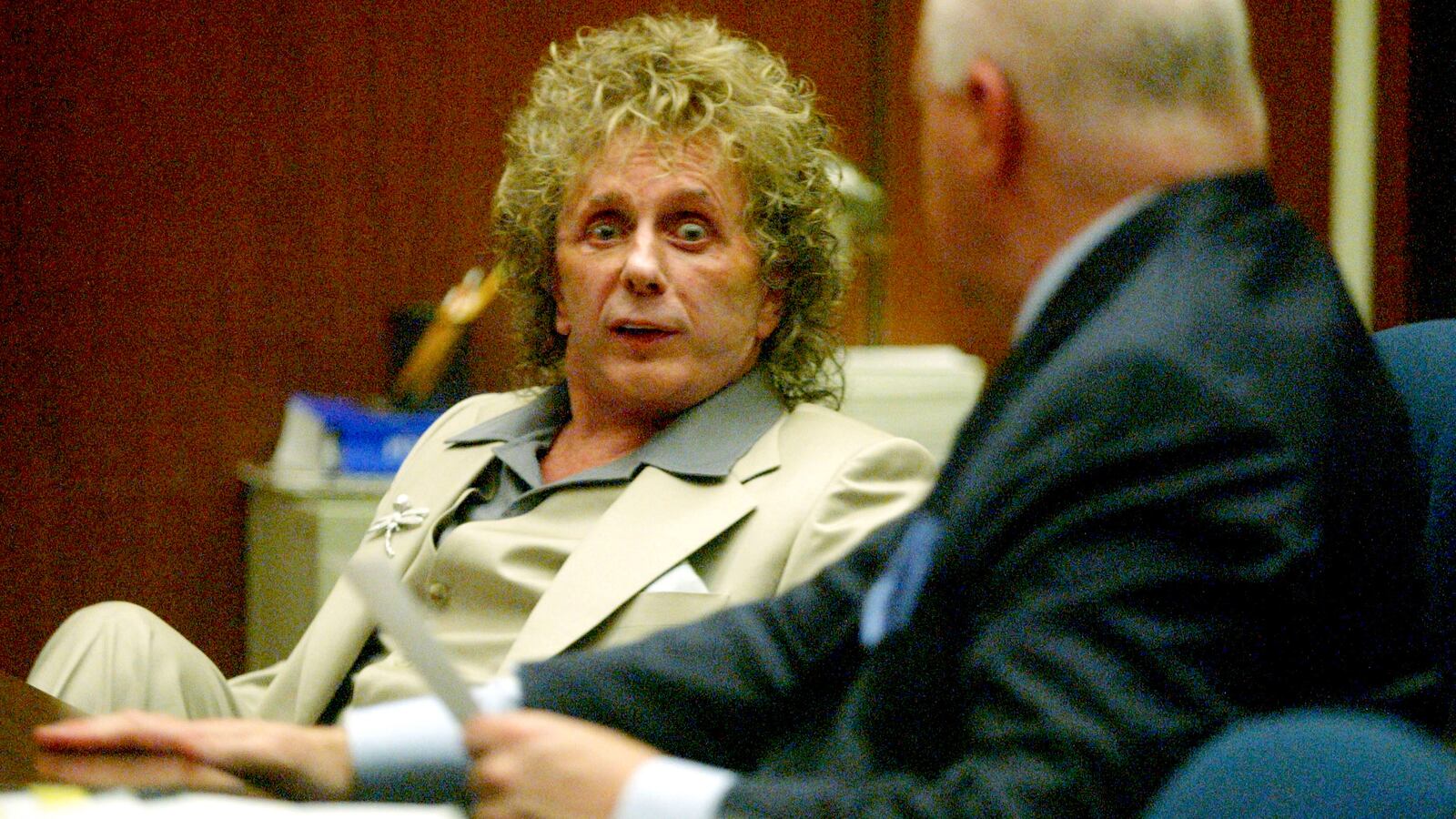The question of how to feel about art created by monstrous artists has risen to the fore over the past decade courtesy of high-profile scandals involving, among others, Bill Cosby, Woody Allen, and Michael Jackson. Spector, directors Sheena M. Joyce and Don Argott’s four-part Showtime docuseries (Nov. 4) about the legendary “Wall of Sound” music producer Phil Spector, cops to having no absolute answer on that subject. What it does know, however, is that Spector was guilty of the Feb. 3, 2003, slaying of 40-year-old actress Lana Clarkson in the mogul’s palatial Pyrenees Castle home in Alhambra, California. An examination of a maniacal titan whose compulsions finally resulted in murder, it’s as even-handed and comprehensive as it is damning beyond a reasonable doubt.
Spector attended his trial in a variety of outlandish wigs that were highlighted by a giant afro that became a running pop-culture joke and stands as arguably his defining image—not only because of its sheer ludicrousness, but because it speaks to his derangement. Spector makes plain that the reclusive producer’s 2003 killing was less a random incident than the culmination of lifelong compulsions and hang-ups that began at an early age, when his father committed suicide and, consequently, saddled him with abandonment issues. On top of that, his mother and sister were apparently a tyrannical pair with whom he violently fought, inspiring a combativeness—and, it’s implied, a latent anger against women—that festered as the clan moved to Los Angeles and Spector, attending Fairfax High School, proved himself a musical wunderkind.
With his group The Teddy Bears (alongside singer Carol Connors, who’s one of many collaborators and acquaintances featured here), the 19-year-old Spector had a No. 1 smash with 1958’s “To Know Him Is to Love Him”—a title taken from his father’s tombstone. Before long, he was forming his own record label (and splitting with his controlling mom and sister) and developing a uniquely symphonic style known as the “Wall of Sound” that became the veritable soundtrack for a generation. Through interviews, archival clips and recordings, and photographs, Spector captures not just the revolutionary nature of that approach, but the way in which it arrived at the right moment in time, helping create a modern—and previously non-existent—teen culture. Seismic hits would follow with the likes of Tina Turner and the Righteous Brothers, cementing his status as a musical genius.
Spector was on the cutting edge, and moreover, he was his songs’ real star. Connors, Darlene Love, The Crystals’ LaLa Brooks and more discuss how Spector viewed musicians as mere tools for his own virtuosity—a notion underlined by snippets of his appearances in Easy Rider and I Dream of Jeannie, as well as on The Merv Griffin Show. In that last instance, Spector comes off as arrogant, manic and combative, which were also key facets of his persona. Spector is rife with anecdotes about the producer wielding guns (and pointing them at people’s heads) in the studio, and that violence was intricately tangled up with his loneliness, little-man insecurities, domineering misogyny—epitomized by his isolating marriage to Ronnie Spector, which she literally fled, barefoot—and his persistent persecution complex.
Much of Spector is driven by commentary from journalist Mick Brown, whose interview with Spector for a magazine article (three weeks before his arrest) provided a rare glimpse into his withdrawn world. Directors Joyce and Argott present portions of both that chat’s audio recordings and Spector’s own post-arrest videos to capture a sense of his twisted headspace, all as various participants—including his daughter Nicole—recount his difficulties with alcohol and mental illness, for which he took countless prescription medications. Booze and pills do not a good combination make, and it’s clear that such a diet only further fueled his instability and seclusion.
Spector’s volatile problems and impulses ultimately begat tragedy on Feb. 3, 2003, when he visited the House of Blues during a bender and met Clarkson. A statuesque beauty with a résumé full of B-movie and commercial roles, Clarkson was one of Hollywood’s innumerable on-the-cusp actors struggling to make it big, and following a horrible wrist injury that had temporarily derailed her career, she was working at the door of the club as a means of meeting people in the hopes of kickstarting her fortunes. There, she encountered Spector, and despite being unaware of who he was, she agreed—after being told to treat him as she would House of Blues owner Dan Aykroyd—to go back to Pyrenees Castle for a drink. It would be a catastrophic mistake, leading to her death by gunshot in his foyer, and an ensuing case that gripped a country already reeling from the prior acquittals of celebrity murder defendants O.J. Simpson and Robert Blake.
Spector’s revisitation of that trial includes input from both defense attorney Linda Kenney Baden and deputy district attorney Alan Jackson, the former making unpersuasive arguments about her client’s innocence—which hinged on the idea that Clarkson killed herself, as supposedly confirmed by forensic evidence—and the latter turning out to be a staunch and admirable prosecutor determined to attain justice. Though an initial jury failed to reach a decision, Jackson soldiered on, and more than one relative and friend of Clarkson makes sure to praise him for his dedication to not letting Spector walk free simply because he had the money, clout and reputation to do so in a city that prized those things above all else.
Joyce and Argott’s docuseries conclusively establishes Spector’s culpability, as well as the confluence of forces that drove him to commit his heinous deed. More moving still, though, is its desire—overtly articulated by multiple interviewees—to restore the good name of Clarkson, a hard-working actress who was denigrated as merely a B-movie failure by Spector’s defense team and the media. With palpable empathy, it redeems Clarkson by understanding her as a shrewd, beloved, ambitious three-dimensional human being whose life was cut short for no reason other than that she happened to cross paths with a violently unhinged man. She may not have been a pioneering legend like her killer, but Spector demonstrates that she’s the one in this sad, sordid saga who’s worth remembering.







